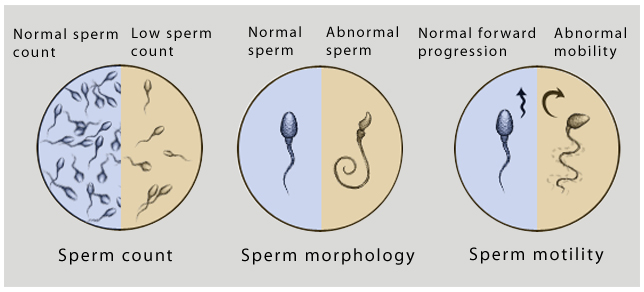Semen analysis measures how much semen a man produces. It also shows the number and quality of sperm in the semen sample. This test is usually one of the first tests done to help find out if a man has a problem fathering a child (infertility). A problem with the semen or sperm affects more than one-third of couples who are unable to have children (infertile).
Tests that may be done during a semen analysis include:
- Volume: This is a measure of how much semen is present in one ejaculation.
- Liquefaction time: Semen is a thick gel at the time of ejaculation. It normally becomes liquid within 20 minutes after ejaculation. Liquefaction time is the time it takes for the semen to turn to liquid.
- Sperm count: This counts the number of sperm present per milliliter (mL) of semen in one ejaculation.
- Sperm morphology: This is a measure of the percentage of sperm that have a normal shape.
- Sperm motility: This is a measure of the percentage of sperm that can move forward normally. The number of sperm that show normal forward movement in a certain amount of semen can also be measured. This is called motile density.
- pH: This is a measure of the acidity (low pH) or alkalinity (high pH) of the semen.
- White blood cell count: White blood cells are not normally present in semen.
- Fructose level: This is a measure of the amount of a sugar called fructose in the semen. The fructose provides energy for the sperm.
Why It Is Done
A semen analysis is done to find out if:
- A man has a reproductive problem that is causing him to be infertile
- A vasectomy has been successful.
- The reversal of a vasectomy has been successful
How To Prepare
You may be asked to avoid any sexual activity that results in ejaculation for 2 to 5 days before this test. This helps to make sure that your sperm count will be at its highest. It also makes the test more reliable. If possible, do not avoid sexual activity for more than 1 to 2 weeks before this test. A long time without sexual activity can result in less active sperm.
You may be asked to avoid drinking alcohol for a few days before the test.
A few of the common normal values are listed below:
- The normal volume varies from 1.5 to 5.0 milliliter per ejaculation
- The sperm count varies from 20 to 150 million sperm per milliliter
- At least 60% of the sperm should have a normal shape and show normal forward movement (motility)
Normal value ranges may vary slightly among different laboratories. Talk to your doctor about the meaning of your specific test results.
The examples above show the common measurements for results for these tests. Some laboratories use different measurements or may test different specimens.
It is not completely clear how these values and other results from a semen analysis should be interpreted. An abnormal result does not always mean there is a problem with a man’s ability to have children.
What Abnormal Results Mean
Abnormal results may suggest a male infertility problem. For example, if the sperm count is very low or very high, a man may be less fertile. The acidity of the semen and the presence of white blood cells (suggesting infection) may affect fertility. Testing may reveal abnormal shapes or abnormal movements of the sperm.
However, there are many unknowns in male infertility. Further testing may be needed if abnormalities are found. Many of these problems are treatable.
Risks
There are no risks.
Considerations
The following may affect a man’s fertility:
- Alcohol
- Many recreational and prescription drugs
- Tobacco


Recent Comments